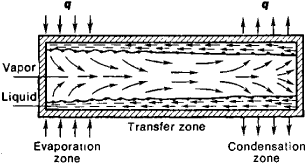The main purpose of a heat pipe is to allow heat transfer from one
location to another. Heat pipes contain fluid, which permits the
transportation of heat through evaporation and condensation. Heat pipes
consist of three component parts, including an evaporator section, an
adiabatic section, and a condenser section. The evaporator section is
the portion of the pipe where the fluid within it will turn from a
liquid into a gas after receiving heat energy from an outside source.
The adiabatic section is the pathway that the newly turned gas will
travel through to reach the other end of the pipe. At the far end of the
pipe, or the condenser section, the gas will condense back into a
liquid, and travel down into the evaporator section. While becoming a
liquid, the gas will release heat into the environment through the
material of the pipe. The process repeats itself afterwards and can
therefore be declared continuous.
The
newly turned liquid from the condenser section can travel back down the
pipe with the help of gravity as well as capillary forces. A wick
within the pipe will support and enhance the capillary forces already
involved. The fluid chosen to fill the pipe should be chemically
well-suited to the material used to build the pipe and the component
material of the wick. The material of the pipe itself should have a high
thermal conductivity as well as a high melting point in order to
withstand and endure the application of any amount of heat.
The
fluid in the evaporator section is able to evaporate after a certain
amount of heat is applied to it because the vapor pressure of the
working fluid is equal to the pressure of the air above it. After
traveling a large distance to the cooler end of the pipe, the vapor
loses energy to the environment in the form of heat. The cooler vapor,
now at the condenser section, has no other pathway to travel through
except back into the evaporator section. Also, vapor is still traveling
through the adiabatic section, which means that the traveling vapor will
force the liquid at the condenser section to make way, thereby forcing
it down the pipe. The liquid will travel down the inner walls of the
pipe, which can be outlined by a wick.
Various
limitations can affect the performance and function of a heat pipe.
Some of the limitations include the sonic limit, entrainment limit,
capillary limit, and boiling limit. The sonic limit is when the vapor
flow is inhibited due to its high velocity. The entrainment limit occurs
when the overall liquid flow doesn’t go smoothly in the pipe because
the liquid is returned back into the condenser section instead of
traveling to the evaporator section. The capillary limit is observed
when the capillary forces within the pipe don't have enough pressure to
force the liquid into the evaporator section. The boiling limit has to
do with the formation of vapor bubbles in the pipe, due to nucleate
boiling, which later prevents the liquid from entering the evaporator
section.
[1] J. Huzvar and P. Nemec, "Mathematical Calculation of the Total Heat Power of the Sodium Heat Pipe", University of Zilina, Slovac Republic.
Works Cited
[2] "Heat Pipe Product Reliability", Advanced Cooling Technologies Inc.
[3] F. Korn, "Heat pipes and its applications", Lund University, Sweden, 2008.
[4] "Sanyo HIP-210NKHA5 Solar Panels", Sanyo, Available: http://www.gridtie-solar.com/solar-panels/10/Sanyo_HIP-210NKHA5.html

No comments:
Post a Comment